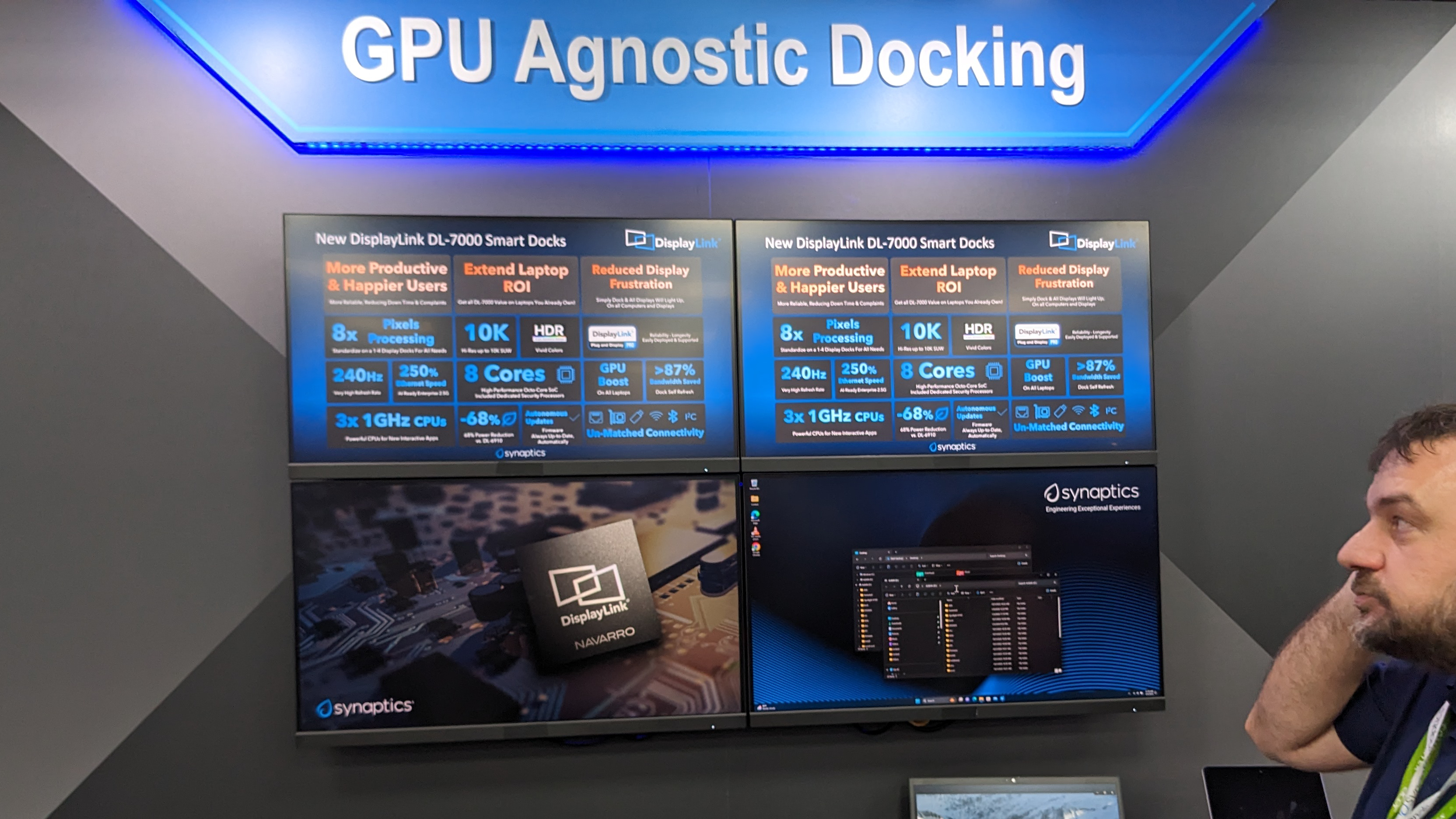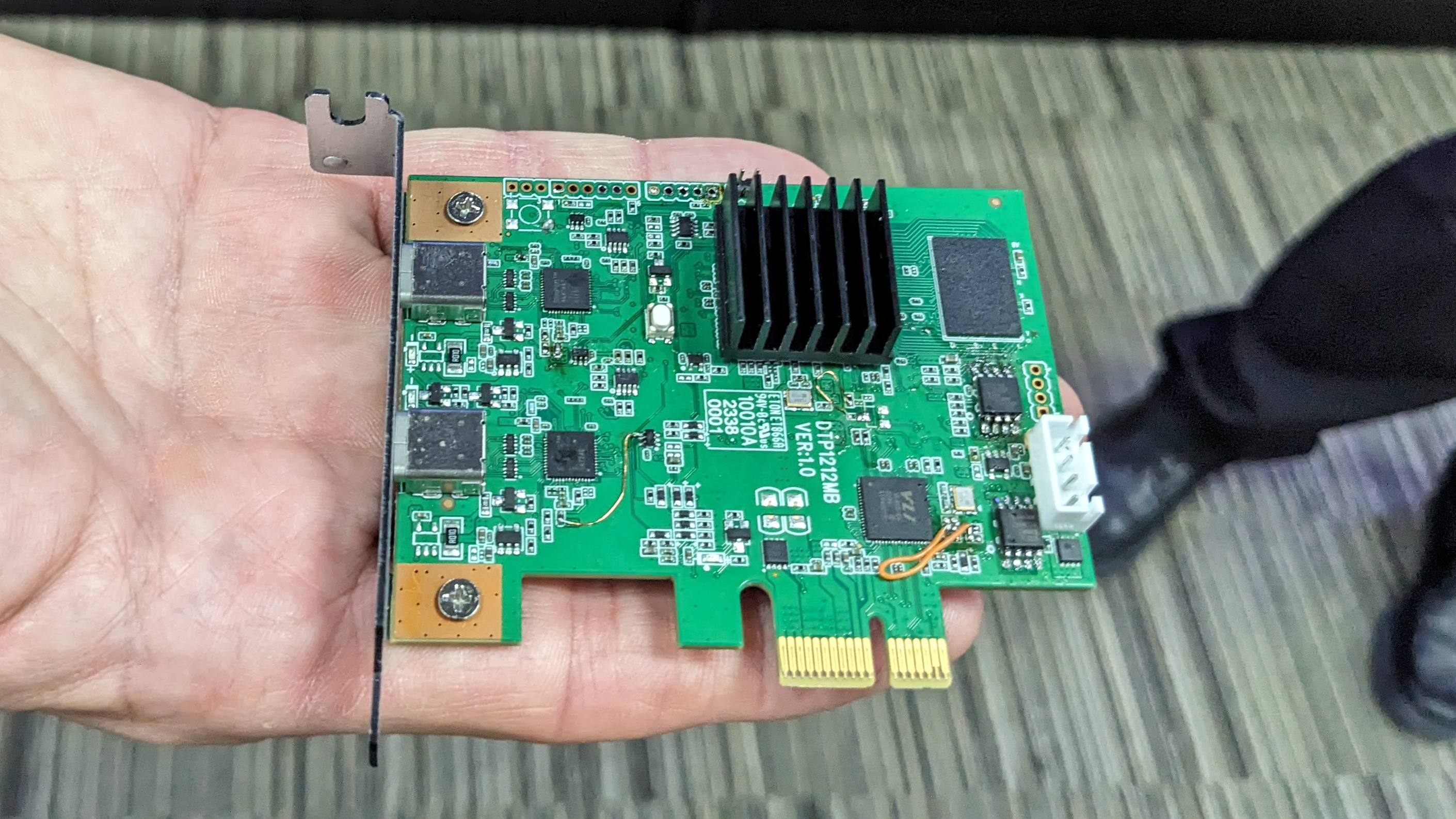This graphics card makes it easy to have more than four displays — sub-$100 DisplayLink adapter uses a PCIe x1 slot
If you want a fifth, sixth or even eighth monitor, this card is for you.

I can't live without my four-way 4K monitor setup that I use for my home workstation. I really appreciate being able to put my chat window on one monitor, play a video on another, and still have two screens for regular work. In fact, I'd really like to up my game to six monitors, but there's a small problem. My graphics card, like pretty much every other recent graphics card on the market, has just four fibeo ports. If I want a fifth monitor, I'm going to need to add another GPU.
But graphics cards, even the low-end ones, don't come cheap and many motherboards don't have more than one slot that's long enough to accommodate a second GPU. Fortunately, Synaptics will soon have an inexpensive and space-saving solution: a sub-$100 single-slot PCIe x1 card based on its DisplayLink DL-7400 chip.
Known for powering USB docking stations with one to four monitor outputs, Synaptics' DisplayLink technology works by utilizing your computer's resources — which can be a combination of your CPU and GPU — to send video to monitors connected via USB.
This allows a laptop to connect to a DisplayLink dock over a single USB 3.0 port and output to several monitors — along with providing relevant USB ports, Ethernet, and a microSD card reader. Unlike other docking solutions that might use Thunderbolt or USB's alternative mode to output a DisplayPort or HDMI signal, DisplayLink is GPU agnostic. It only needs you to have a USB port and it can even work relatively well on an old computer.

DisplayLink technology has been around for many years, but devices based on the new DL-7400 chip are just starting to hit the market. The DL-7400 can power up to four 4K monitors running at 120 Hz, or two 8K monitors running at 60 Hz with HDR10. And it manages all that with a limited impact on performance. It's not meant for gaming but it can handle casual games.
What's new is that the DL-7400 will now also be used to power PCIe cards that you can use to build or upgrade a desktop PC. The cards will be really compact — the one I saw on display at Synaptics' Computex booth had a single-slot PCIe x1 form factor — but it's unclear if other solutions might offer a physical x2, x4, or even x16 connector. They'll be cheap, though, and a DisplayLink spokesperson said definitely sub-$100 and possibly a lot less.

And there will be different versions: Some will have a couple of USB-C ports that can deliver a DisplayPort signal and others will have a full array of HDMI / DisplayPort outputs. Because Synaptics works as a licensor, we can expect these cards to come out under a variety of different brands.
The big benefit is that desktop users can easily increase the number of monitors they can use, without buying a larger (or older) discrete GPU that may be expensive and require an x4 or x16 slot. If you have a small PC with an integrated GPU that supports only one or two outputs, you can easily add another two to four. If, like me, you have a discrete GPU that outputs to four monitors and you want to jump up to six or eight monitors, this PCIe card will get you there much more cheaply than buying a second graphics card. And if you have enough slots, you could even buy multiple DisplayLink PCIe cards and keep adding more monitors — 16-way wall screens, anyone?
It's also possible, but we won't know until we test, that gamers in multi-monitor setups could see a performance boost by putting all of their secondary displays onto the DisplayLink PCIe card and leaving only their main gaming screen on their discrete GPU. This might leave more resources for the discrete GPU to use on your game, but it's unclear if those gains would be material or if the added weight of the DisplayLink software and its CPU use would drown them out.
PCIe cards based on the DisplayLink DL-7400 chip are due out later this year. We don't know the exact pricing or all the different options that will be available, but we should know more soon.
Get Tom's Hardware's best news and in-depth reviews, straight to your inbox.
Avram Piltch is Managing Editor: Special Projects. When he's not playing with the latest gadgets at work or putting on VR helmets at trade shows, you'll find him rooting his phone, taking apart his PC, or coding plugins. With his technical knowledge and passion for testing, Avram developed many real-world benchmarks, including our laptop battery test.
-
usertests ReplyThe DL-7400 can power up to four 4K monitors running at 120 Hz, or two 8K monitors running at 60 Hz with HDR10. And it manages all that with a limited impact on performance. It's not meant for gaming but it can handle casual games.
What does this mean? -
plateLunch Sounds like something you could make a good stock trading setup with. You don't need fancy gaming graphics but having a lot of monitors running with different charts is nice.Reply -
cyrusfox Displaylink works great in a dock, for an extra display, but the refresh rate as well as the CPU resources used are noticeable from my past experience, For a modern platform, maybe not much of an issue. The output is perfectly suitable for coding and research, but painful for video or any motion. . As most GPU's already sport 4 displays available and additionally if you use intel and have the iGPU switched on in the bios, that is another 4 displays available(although most mobo only have 2 outputs available), not sure on the use case.Reply
For focus I am now finding less is more, but do whatever works best for your workflow. This may be a bargain for digital signage, an update to the old slim HD 5450 output gpus. Its the sole reason I bought a GT 1030 for $80 back in 2017. -
cyrusfox Reply
DisplayLink adds a new translational level, so expect to have an added latency hit, which means it will be no fun playing games that require any sort of quick reaction time. Turn based games should be no issue.usertests said:What does this mean? -
abufrejoval Reply
Mostly that it's a pure 2D device with probably some video acceleration where any 3D would have to be done by the CPU.usertests said:What does this mean?
Now actually an iGPU's or dGPU's power could probably be harnished having them render in off-screen pixmaps, which would the be either transcoded or simply BitBlt to the (probably) on card frame buffer, but that's a lot of software work (similar to Steam Remote) for limited benefits DL will want to avoid.
And that means doing 2D stuff on the monitors connected to DL adapters should be just fine. If you're intending to play GPU intensive games, better use the screens connected to those. -
jabliese I do not believe this, my computer has no reference to a fibeo port. What is this magic that Avram Piltch can find on most recent graphics cards? Please let this not be a typo, a fibeo port sounds like just what my computer needs for more sparkle!Reply
